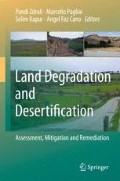Abstract
The aim of this study was to determine the effects of organic wastes such as bio-solid (BS) and tea waste (TW) on erosion ratio index (ER) of eroded soils in different levels (slight, moderate and severe). Soil samples used in this research were taken from surface soil (0–20 cm depth) located on agricultural land of Samsun province in the northern part of Turkey. These soil samples were treated with organic residues at four different levels (0, 2, 4, and 6% basis w/w) and each treatment was replicated three times in a split block design. All pot mixtures were incubated for 4 weeks under greenhouse conditions and later tomato plants were grown in all pots. When plant growth was in its 14th week, the experiment was ended. After greenhouse work, changes in ER values of eroded soils were determined. It was determined that the BS and TW treatments dramatically decreased ER values of the eroded soils compared to the control treatment. Statistical test results showed that erosion level (p <0.001), type of residue (p <0.01) and the application dose (p <0.001) caused the changes of the ER values.
Access this chapter
Tax calculation will be finalised at checkout
Purchases are for personal use only
References
Anonymous. (2002). Samsun Climatic Data (1974–2001) State Meteorology Services. Unpublished, Ankara, Turkey.
Brandsma, R.T., Fullen, M.A. and Hocking, T.J. (1999). Soil conditioner effects on soil structure and erosion. Journal of Soil and Water Conservation 54(2):485–489.
Choudhary, M.A., Lal, R. and Dick, W.A. (1997). Long-term tillage effects on runoff and soil erosion under simulated rainfall for a central Ohio soils. Soil and Tillage Research 42:175–184.
Demiralay, I. (1993). Toprak Fiziksel Analizleri (in Turkish). Erzurum
Ekwue, E.I. (1990). Organic matter effects on soil strength properties. Soil and Tillage Research 16:289–294.
Haynes, R.J. (2000). Interactions between soil organic matter and their effect on measured aggregate stability. Biology and Fertility of Soils 30:270–275.
Institıte, S.A.S. (1988). SAS/STAT User’s Guide, Release 6.03 Edition. SAS Institute, Cary, NC.
Kacar, B. (1994). Bitki ve Topragin Kimyasal Analizleri (in Turkish). Ankara
Lal, R. (1988). Soil Erosion Research Methods. Soil and Water Conservation Society, Ankeny, Iowa, pp. 141–153.
Mitra, B., Scott, H.D., Dixon, J.C. and McKimmey, J.M. (1998). Applications of fuzzy logic to the prediction of soil erosion in a large watershed. Geoderma 86:183–209.
Nelson, D.W. and Sommers, L.E. (1982). Total carbon, organic carbon and organic matter. In: Page A.L. (ed.), Methods of Soil Analysis, Part 2, Chemical and Microbiological Properties. Agronomy Monograph No 9. ASA Inc, Madison, WI, pp. 539–580.
Ngatunga, E.L.N., Lal, R. and Singer, M.J. (1984). Effects of surface management on runoff and soil erosion from some plot Milangano, Tanzania. Geoderma 33:1–12.
Ozdemir, N. (1993). Effects of admixturing organic residues on structure stability and erodibility of soils. Journal of Ataturk University Faculty of Agriculture 24(1):75–90.
Ozdemir, N. and Askin, T. (2003). Effects of parent material and land use on soil erodibility. Journal of Plant Nutrition and Soil Science 166:774–776.
Ozturk, H.S., Turkmen, C., Erdogan, E., Baskan, O., Dengiz, O. and Parlak, M. (2005). Effects of a soil conditioner on some physical and biological features of soils: Results from a greenhouse study. Bioresource Technology 96:1950–1954.
Rowell, D.L. (1996). Soil Science Methods and Applications. Wesley Longman Limited, Harlow.
Sonmez, K. (1979). Mus-Alparslan Devlet Uretme Ciftligi arazisinde yüzeyden alinan topraklarin strukturel dayanikliliği ve erozyona duyarliliği uzerine bir arastirma. Journal of Ataturk University Faculty of Agriculture 10(3–4):17–26.
Tumsavas, Z. and Katkat, A.V. (2000). A study on the determination of erodibilities of the sloping agricultural soils in the city of Bursa and vicinity against water erosion in laboratory conditions. Turkish Journal of Agriculture and Forestry 24:737–744.
Turgut, B., Olgun, M., Kucukozdemir, U., Karadas, K. and Gulseven, D. (2004). Effect of some organic residues on erodibility of soils. Paper Presented at the International Soil Congress (ISC) on Natural Resource Management Sustainable Development, Ataturk University, Erzurum, 7–14 June 2004.
USDA. (2003). Key to Soil Taxonomy. 9th edn. USDA, Natural Resources Conservation Services, Washington.
Vanelslande, A., Lal, R. and Gabriels, D. (1987). The erodibility of some Nigerian soils: A comparison of rainfall Simulator results with estimates obtained from the Wischmeier nomogram. Hydrological Processes 1:255–265.
Zhang B, Horn R and Hallett PD (2005). Mechanical resilience of degraded soil amended with organic matter. Soil Science Society of America Journal 69:864–871
Author information
Authors and Affiliations
Corresponding author
Editor information
Editors and Affiliations
Rights and permissions
Copyright information
© 2010 Springer Science+Business Media B.V.
About this chapter
Cite this chapter
Ozdemir, N., Yakupoglu, T., Ozturk, E., Dengiz, O. (2010). The Effect of Bio-solid and Tea Waste Applications on Erosion Ratio Index of Eroded Soils. In: Zdruli, P., Pagliai, M., Kapur, S., Faz Cano, A. (eds) Land Degradation and Desertification: Assessment, Mitigation and Remediation. Springer, Dordrecht. https://doi.org/10.1007/978-90-481-8657-0_28
Download citation
DOI: https://doi.org/10.1007/978-90-481-8657-0_28
Published:
Publisher Name: Springer, Dordrecht
Print ISBN: 978-90-481-8656-3
Online ISBN: 978-90-481-8657-0
eBook Packages: Earth and Environmental ScienceEarth and Environmental Science (R0)

